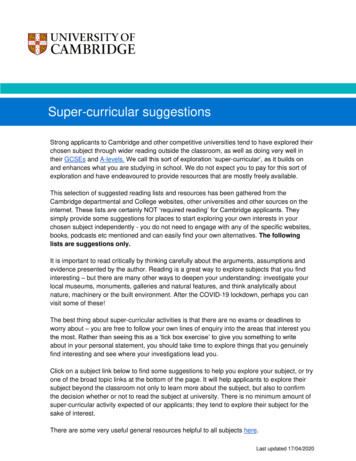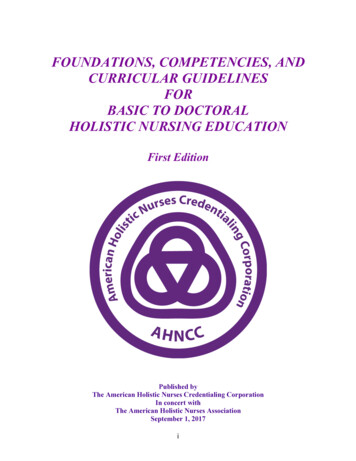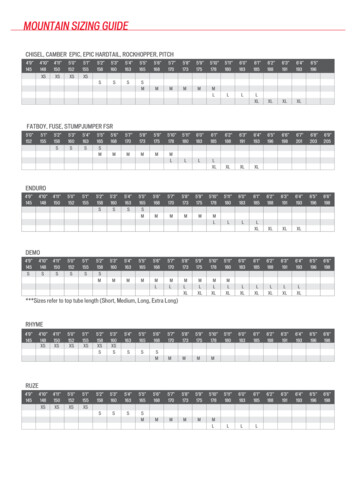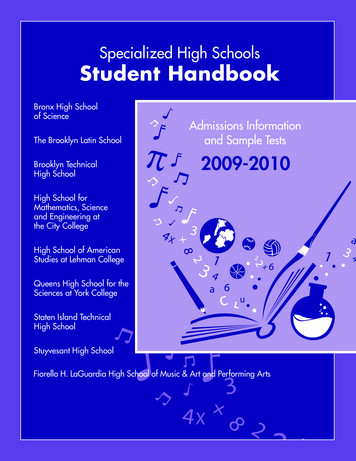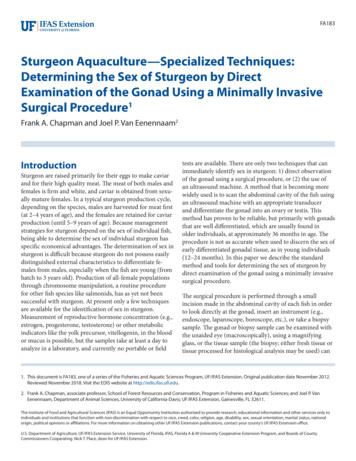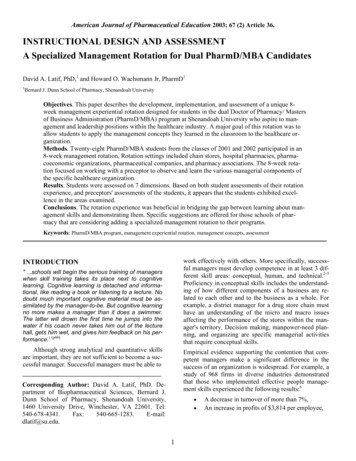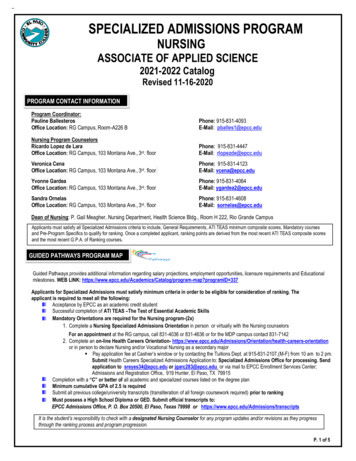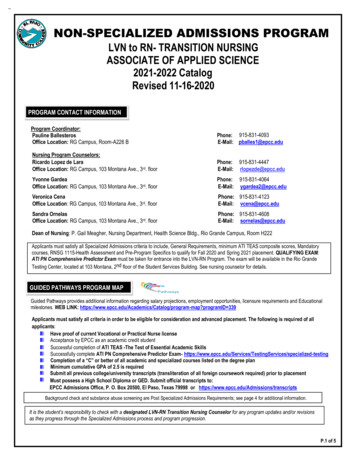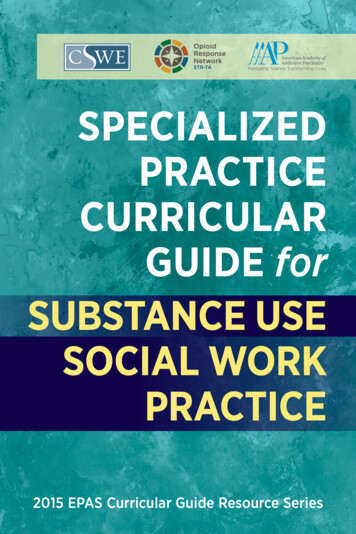
Transcription
SPECIALIZEDPRACTICECURRICULARGUIDE forSUBSTANCE USESOCIAL WORKPRACTICE2015 EPAS Curricular Guide Resource Series
SPECIALIZEDPRACTICECURRICULARGUIDE forSUBSTANCE USESOCIAL WORKPRACTICE
SPECIALIZEDPRACTICECURRICULARGUIDE forSUBSTANCE USESOCIAL WORKPRACTICE2015 EPAS Curricular GuideResource SeriesCouncil on Social Work EducationAlexandria, Virginia
Copyright 2020, Council on Social Work EducationPublished in the United States by the Council on Social Work Education, Inc. All rightsreserved. No part of this book may be reproduced or transmitted in any manner whatsoever without the prior written permission of the publisher.ISBN 978-0-87293-201-2Council on Social Work Education1701 Duke Street, Suite 200Alexandria, VA 22314-3457www.cswe.org
AcknowledgmentsFunding for this initiative was made possible(in part) by grant no. 6H79TI080816 fromSAMHSA. The views expressed in writtenconference materials or publications and byspeakers and moderators do not necessarily reflect the official policiesof the Department of Health and Human Services; nor does mention oftrade names, commercial practices, or organizations imply endorsementby the U.S. Government.This document was developed through the generous support of theAmerican Academy of Addiction Psychiatry and the Council on SocialWork Education.STEERING COMMITTEECHAIRSMartha Haley-BowlingFerrum CollegeAnthony EstreetMorgan State UniversityTanya GreathouseMetropolitan State University DenverRebecca GomezOur Lady of the Lake UniversityWhitney HarperWestern Kentucky UniversityMarilyn W. LewisNorfolk State UniversityNATIONAL TASK FORCESTEERING COMMITTEEMonica MatthieuSaint Louis UniversityAudrey BegunOhio State UniversityPaul SaccoUniversity of MarylandManuel CanoUniversity of Texas at San AntonioShelly WiecheltUniversity of Maryland, Baltimore Countyv
viSPECIALIZED PRACTICE CURRICULAR GUIDE FOR SUBSTANCE USE SOCIAL WORK PRACTICENATIONAL TASK FORCEShauna AcquavitaUniversity of CincinnatiTara AndersonUniversity of St. ThomasJennifer AndersonUniversity of Wisconsin -WhitewaterJoan BlakeyTulane UniversityJoanna (Jody) BrookUniversity of KansasNancy K. BrownUniversity of South CarolinaDaniel L. BuccinoJohns Hopkins HospitalJerry BuieUniversity of UtahMichael Scott CampbellUniversity of Saint LeoKala ChakradharMurray State UniversityColeen CicaleTulane UniversityTerry Cluse-TolarOhio UniversityShannon Cooper-SadloSaint Louis UniversityDennis CorbinFayetteville State UniversityGrace CreasmanEastern Washington UniversityTracy CudjoeMorgan StatePeter DelanyGeorge Mason UniversityJennifer DellUniversity of OklahomaJames DiRedaAnna Maria CollegeLaura DonavonAurora UniversityCarol S. DrolenUniversity of AlabamaE. Delores Dungee-AndersonNorfolk State UniversityMalitta EngstromUniversity of PennsylvaniaSusan Michele EspBoise State UniversityDaniel FreedmanUniversity of South CarolinaMartha Lucia GarciaMarist CollegeVannessa GharbiNorth Carolina Agricultural andTechnical UniversityWendy GrabWilmington CollegeDorothy S. GreeneEast Tennessee State UniversityAna GuerraKean UniversityJodi HelbertKing UniversityAmber HolbrookWest Chester UniversityDavid HusseyCase Western Reserve UniversityNancy Jo KeppleUniversity of KansasToula KourgiantakisUniversity of TorontoMichael LloydLewis University
AcknowledgmentsMichael McGuireUniversity of North Carolina, Chapel HillDiane RulloWalden UniversityTracy McPhersonNORC at the University of ChicagoTodd SageUniversity at BuffaloBrian MillerUniversity of New HampshireStephanie Elias SarabiaRamapo College of New JerseyMatthew MitchellSaginaw Valley State UniversityPatricia Tobin SengerSaint Leo UniversityKristina MontiAdelphi UniversitySandra M SheppardUniversity at BuffaloLucas MooreUniversity of Wisconsin – MadisonChristopher SolomonNorth Carolina Central UniversityOrion MowbrayUniversity of GeorgiaShelley SteenrodSalem State UniversityPeggy Pittman MunkeMurray State UniversityS. Lala StraussnerNew York UniversityMargaret (Peggy) MurrayNIAAA/NIH (Retired)An-Pyng SunUniversity of Nevada Las VegasLaura NissenPortland State UniversityWilliam ThomasClark Atlanta UniversityLia NowerRutgers UniversityMicki WashburnUniversity of Texas- ArlingtonVikki O'ConnorKeuka CollegeLisa E. WatsonSpringfield CollegeNora PadykulaWestfield State UniversityBrooke WestColumbia UniversityRhonda G. PatrickUniversity of HoustonEveldora WheelerWest Liberty UniversityJohn PaulsonUniversity of Southern IndianaShanika Lavi WilsonUniversity of North Carolina CentralUniversityFanica J. PayneWest Virginia UniversityRegina T. PraetoriusUniversity of Texas – ArlingtonElaine RinfretteEdinboro UniversityJessica YangWinthrop UniversityBeth YoungWestern Carolina UniversityMarsha Zibalese-CrawfordTemple Universityvii
viiiSPECIALIZED PRACTICE CURRICULAR GUIDE FOR SUBSTANCE USE SOCIAL WORK PRACTICECOUNCIL ON SOCIALWORK EDUCATIONElizabeth SimonPublications ManagerDarla Spence CoffeyPresident and CEOMumbi MwauraProgram Associate, CurricularResourcesJo Ann Coe ReganVice President of EducationJulie RhoadsDirector, Education Initiatives andResearchAndrea BediakoFormer Associate Director ofEducational Initiatives and Research
ContentsAcknowledgments . . . . . . . . . . . . . . . . . . . . . . . . . . . . . . . . . . . . . . . . . . . . . . . . . . . . . . . vContents . . . . . . . . . . . . . . . . . . . . . . . . . . . . . . . . . . . . . . . . . . . . . . . . . . . . . . . . . . . . . . . . ixPreface: Competency-based Education . . . . . . . . . . . . . . . . . . . . . . . . . . . . . . . . . xiiiIntroduction . . . . . . . . . . . . . . . . . . . . . . . . . . . . . . . . . . . . . . . . . . . . . . . . . . . . . . . . . . . xviiCompetency 1Demonstrate Ethical and Professional Behavior . . . . . . . . . . 1Appendix 1A: Orientation Exercise for Professional Responsibilityand Lifelong Learning . . . . . . . . . . . . . . . . . . . . . . . . . . . . . . . . . . . . 1 1Appendix 1B: Engagement and Assessment Simulation . . . . . . . . . . . . . . . . . . . 12Appendix 1C:Self-Assessment . . . . . . . . . . . . . . . . . . . . . . . . . . . . . . . . . . . . . . . . . 13Competency 2Engage Diversity and Difference in Practice . . . . . . . . . . . . . 15Competency 3 Advance Human Rights and Social, Economic,and Environmental Justice . . . . . . . . . . . . . . . . . . . . . . . . . . . . . 27Appendix 3A: Learning Activities on Changing Marijuana Policiesand Attitudes . . . . . . . . . . . . . . . . . . . . . . . . . . . . . . . . . . . . . . . . . . . . 37Appendix 3B: Field Assignment on Detecting Biases About PeopleWho Use Drugs or Are Alcohol or Drug Dependent . . . . . . . . . . . 37Competency 4 E ngage in Practice-informed Research andResearch-informed Practice . . . . . . . . . . . . . . . . . . . . . . . . . . . . 39Appendix 4A:Theory-informed Research and Practice for Substance Use . . . . . 47Appendix 4B:Formulate a Research Question for Substance Use Research . . . 49ix
xSPECIALIZED PRACTICE CURRICULAR GUIDE FOR SUBSTANCE USE SOCIAL WORK PRACTICECompetency 5Engage in Policy Practice . . . . . . . . . . . . . . . . . . . . . . . . . . . . . . . 53Competency 6 ngage With Individuals, Families, Groups,EOrganizations, and Communities . . . . . . . . . . . . . . . . . . . . . . . 61Appendix 6A: Motivational Interviewing Practice – Small Group Exercise . . . . 67Appendix 6B: Exploring the Use of Harm Reduction Strategies forEngagement into Treatment . . . . . . . . . . . . . . . . . . . . . . . . . . . . . . . 68Appendix 6C: Recovery Month Activity . . . . . . . . . . . . . . . . . . . . . . . . . . . . . . . . . 69Appendix 6D: Develop an Outreach Tool for Engaging Community Membersinto Active Change . . . . . . . . . . . . . . . . . . . . . . . . . . . . . . . . . . . . . . . 70Appendix 6E: Review of Evidence Based Approaches to Substance UseDisorder Intervention-with a Focus on Engagement . . . . . . . . . . 7 1Appendix 6F: Group Paper and Presentations on Special Populations . . . . . . . 72Appendix 6G: Twelve-Step Meeting Observation & Reflection . . . . . . . . . . . . . . 73Competency 7 Assess Individuals, Families, Groups,Organizations, and Communities . . . . . . . . . . . . . . . . . . . . . . . 75Appendix 7A:SBIRT Assignments . . . . . . . . . . . . . . . . . . . . . . . . . . . . . . . . . . . . . . . 83Appendix 7B:Engagement Scenarios . . . . . . . . . . . . . . . . . . . . . . . . . . . . . . . . . . . 84Appendix 7C:Emilia Sanchez and Social Worker . . . . . . . . . . . . . . . . . . . . . . . . . . 86Appendix 7D:Mythbusters Assignment . . . . . . . . . . . . . . . . . . . . . . . . . . . . . . . . . . 87Appendix 7E:Stories on Addiction . . . . . . . . . . . . . . . . . . . . . . . . . . . . . . . . . . . . . . 89Appendix 7F: Family-centered Practices in Addictions GroupPresentation . . . . . . . . . . . . . . . . . . . . . . . . . . . . . . . . . . . . . . . . . . . . 90Appendix 7G:Opioid Book Review . . . . . . . . . . . . . . . . . . . . . . . . . . . . . . . . . . . . . . 9 1Appendix 7H:Policy Assignment . . . . . . . . . . . . . . . . . . . . . . . . . . . . . . . . . . . . . . . 93Appendix 7 I :Self-assessment of Preparedness for SUD Practice . . . . . . . . . . . 93Appendix 7J:Self-help Group Papers . . . . . . . . . . . . . . . . . . . . . . . . . . . . . . . . . . . 98Appendix 7K:Summary and Analysis EBP Treatment Paper . . . . . . . . . . . . . . . 99Appendix 7L:Abstaining Exercise . . . . . . . . . . . . . . . . . . . . . . . . . . . . . . . . . . . . . 99Appendix 7M:Field Activity . . . . . . . . . . . . . . . . . . . . . . . . . . . . . . . . . . . . . . . . . . . 101
ContentsxiCompetency 8 Intervene With Individuals, Families, Groups,Organizations, and Communities . . . . . . . . . . . . . . . . . . . . . . 103Appendix 8A-1:Identifying and Languaging Feelings . . . . . . . . . . . . . . . . . . . . . . 121Appendix 8A-2:Treatment Planning . . . . . . . . . . . . . . . . . . . . . . . . . . . . . . . . . . . . . 122Appendix 8A-3:Motivational Interviewing Facilitation . . . . . . . . . . . . . . . . . . . . . . 123Appendix 8A-4:SBIRT Skills Practice . . . . . . . . . . . . . . . . . . . . . . . . . . . . . . . . . . . . . 123Appendix 8A-5:CBT Relapse Prevention Practice . . . . . . . . . . . . . . . . . . . . . . . . . . 124Appendix 8A-6:Harm Reduction Group Work . . . . . . . . . . . . . . . . . . . . . . . . . . . . . 124Appendix 8B-1:Mutual Aid Meeting Assignment . . . . . . . . . . . . . . . . . . . . . . . . . . 125Appendix 8B-2:Case Analysis . . . . . . . . . . . . . . . . . . . . . . . . . . . . . . . . . . . . . . . . . . . 126Appendix 8B-3:Group Presentation on a Special Population . . . . . . . . . . . . . . . . 127Appendix 8B-4:Group Facilitation Demonstration . . . . . . . . . . . . . . . . . . . . . . . . . 128Appendix 8B-5:Motivational Interviewing Reflection Paper . . . . . . . . . . . . . . . . . 129Appendix 8B-6:Prevention Program Planning . . . . . . . . . . . . . . . . . . . . . . . . . . . . . 130Competency 9 valuate Practice With Individuals, Families,EGroups, Organizations, and Communities . . . . . . . . . . . . . . 135Appendix 9A: Lesbian, Gay, Bisexual, or Transgender (LGBT)Older Adults Teaching Module . . . . . . . . . . . . . . . . . . . . . . . . . . . . 139
Preface: Competency-based EducationIn 2008 CSWE adopted a competency-based education framework for itsEducational Policy and Accreditation Standards (EPAS). Competency-basededucation rests on a shared view of the nature of competence in professionalpractice. Social work competence is the ability to integrate and apply socialwork knowledge, values, and skills to practice situations in a purposeful, intentional, and professional manner to promote human and community well-being. EPAS recognizes a holistic view of competence; that is, the demonstrationof competence is informed by knowledge, values, skills, and cognitive andaffective processes that include the social worker’s critical thinking, affectivereactions, and exercise of judgment regarding unique practice situations.Overall professional competence is multidimensional and composed of interrelated competencies. An individual social worker’s competence is seen asdevelopmental and dynamic, changing over time in relation to continuouslearning (CSWE, 2015, p. 6).Competency-based education is an outcome-oriented approach to curriculum design. The goal of the outcome approach is to ensure that students can demonstrate the integration and application of the competenciesin practice. In the EPAS, social work practice competence consists of nineinterrelated competencies and component behaviors that consist of knowledge, values, skills, and cognitive and affective processes. Using a curriculumdesign that begins with the outcomes, expressed as the expected competencies, programs develop the substantive content, pedagogical approach,and educational activities that provide learning opportunities for students todemonstrate the competencies (CSWE, 2015, p. 6).xiii
xivSPECIALIZED PRACTICE CURRICULAR GUIDE FOR SUBSTANCE USE SOCIAL WORK PRACTICESOCIAL WORK COMPETENCIESThe 2015 EPAS stipulates nine competencies for the social work profession.These competencies apply to both generalist and specialized practice. Thenine social work competencies are listed in the 2015 EPAS on pp. 7–9. Each ofthe nine social work competencies is followed by a paragraph that describesthe dimensions (knowledge, values, skills, and cognitive and affective processes) that make up the competency at the generalist level of practice. Thisparagraph describes the content that should be reflected in the generalistsocial work curriculum and represents the underlying content and processesthat inform the behaviors. The bullet points under the paragraph descriptionsin the EPAS are a set of behaviors that integrate the dimensions of the competency and represent observable components of each competency. The dimensions of the competency inform the behaviors.FRAMEWORK FOR THE GUIDEThe CSWE Commission on Educational Policy (COEP) developed a frameworkfor the development of curricular guides for areas of specialized practice. Thetask force followed the guidelines for creating substance use competenciesand curricular resources listed here:1) Identification of an area of specialized practice for a specific population,problem area, method of intervention, perspective, or approach to practice in social work (Educational Policy [EP] M2.1).2) Discussion of how the area of specialized practice builds on generalistpractice as described in EP 2.0 (Accreditation Standard [AS] M2.1.1).3) Identification of the specialized knowledge, values, skills, cognitive andaffective processes, and behaviors that extend and enhance the ninesocial work competencies and prepare students for practice in the areaof specialization identified (EP M2.1 and AS M2.1.3).4) Suggested curriculum content and resources (e.g., readings, multimediaand online resources, modules, assignments, experiential exercises, andclass and field activities) for each of the nine social work competenciesand any additional competencies identified. The curriculum content and
Preface: Competency-based Educationxvresources identified in this guide are not required by accreditation standards and are meant to serve as an optional guide to programs on howto conceptualize trauma-informed social work practice with the ninesocial work competencies identified in the 2015 EPAS.5) Identification of the competency dimensions (knowledge, values, skills,and cognitive and affective processes) associated with the course content for each competency.REFERENCECouncil on Social Work Education. (2015). Educational policy and accreditationstandards. Retrieved from y.pdf.aspx
IntroductionIn the United States an estimated 1 in 14 people, 14.5 million, had a substanceused disorder in 2017.1 Globally it is estimated that as much as 16% of thepopulation has an alcohol use disorder and as many as 3% have a drug usedisorder.2,3 Although this publication is intended to guide specialized practicewith individuals and communities affected by substance use, it is importantto note that the prevalence of problematic substance use and substance usedisorders, as well as the secondary effects (e.g., health, parenting, relational,economic) associated with substance use on individuals and communities,necessitate that all social workers have a minimum competency and knowledge of substance use across the continuum from use to disorder. Socialworkers will interact with those experiencing a substance use disorder or atrisk of a substance use disorder in multiple settings, including child welfareagencies, shelters, skilled nursing facilities, schools, and hospitals. Substanceuse disorders affect all segments of the population.Furthermore, work with substance use disorders is uniquely influenced byseveral factors. The prevalence of substance use disorders results in most socialworkers having exposure to substance use disorders either directly within theirfamily system or indirectly, well before their social work training. In fact, it is1. Substance Abuse and Mental Health Service Administration. (2017). Reports and detailedtables from the 2017 National Survey on Drug Use and Health. -tables-2017-NSDUH2. World Health Organization. (2017). Global health observatory data: Prevalence of alcoholuse disorders. https://www.who.int/gho/substance abuse/burden/alcohol prevalence/en/3. World Health Organization. (2017). Global health observatory data: Prevalence of drug usedisorders. https://www.who.int/gho/substance abuse/burden/drug prevalence text/en/xvii
xviiiSPECIALIZED PRACTICE CURRICULAR GUIDE FOR SUBSTANCE USE SOCIAL WORK PRACTICEestimated that one in four children live with at least one adult with a substanceuse disorder. This means that many social workers will come to this work withtheir own lived experiences and lived perspective. Ethical and effective practice necessitate that social workers in all settings engage in self-reflection andaddress internal bias. Additionally, social workers may be drawn to specializedpractice with substance use disorders because of their own recovery and livedexperiences with substance use disorders. Social workers in recovery havea unique role in contributing to specialized practice. Finally, those with substa
Springfield College Brooke West Columbia University Eveldora Wheeler West Liberty University Shanika Lavi Wilson University of North Carolina Central University Jessica Yang Winthrop University Beth Young Western Caroli
